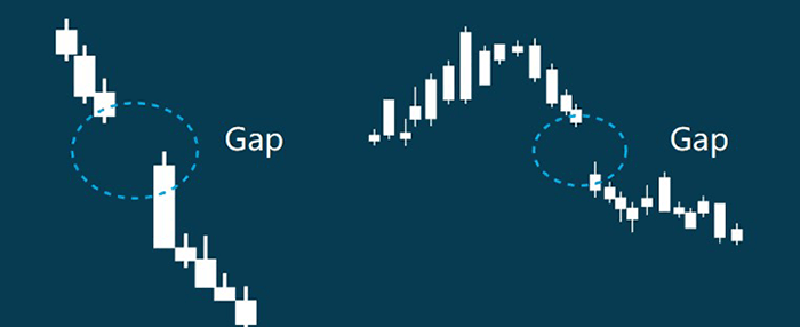Gap theory is one of the theories of foreign exchange investment. Today, in this article, we will learn about the relevant knowledge of gap theory, hoping to be helpful for investors to look at the market.
Concept Description
Gap refers to the phenomenon of a significant increase or decrease in exchange rates due to positive or negative news, resulting in a daily chart of exchange rates where the lowest traded price on the day exceeds the highest traded price on the previous trading day or the highest traded price is lower than the lowest traded price on the previous trading day. Usually, if the gap is not quickly covered, it indicates the possibility of a continuation of the market. If the gap is covered, it indicates the possibility of a reversal of the market.

What are the Types?
1. Ordinary notch
This type of gap usually occurs in dense trading areas, so many consolidation or turning patterns that require a long time to form, such as triangles, rectangles, etc., may have such gaps formed.
2. Breakthrough gap
A breakthrough gap is a gap created when a dense reversal or consolidation pattern is completed and breaks through the market. When the exchange rate jumps away from the pattern with a large gap, it indicates that a real breakthrough has been formed. Because incorrect movements rarely create gaps, and gaps can demonstrate the strength of breakthroughs, the larger the breakthrough gap, the stronger the future changes.
3. Metric Gap
A gap that occurs during an upward or downward trend may be a persistent gap. This type of gap will not be confused with breakthrough gaps. Any rapid rise or fall after leaving the pattern or intensive trading area will mostly result in persistent gaps. This gap can help us estimate the magnitude of future market fluctuations, hence it is also known as a quantitative gap.
4. Exhaustive gap
Like persistent gaps, depletion gaps occur with rapid and significant fluctuations in exchange rates. In a rapid rise or fall, the fluctuation of exchange rates is not gradually showing resistance, but rather becoming increasingly urgent. At this point, a jump in price (or a drop in price) may occur, and this gap is known as a depletion gap.
Usually, the depletion type gap appears at the end of panic selling or consumptive increase.
Application rules
1. The ordinary gap has no special analytical significance and is usually fully filled within a few trading days. It can only help us identify the formation of a certain type. The common type gap has a much greater chance of appearing in the organized form than in the inverted form, so when it is found that there are many gaps in the developing triangle and rectangle, it should be strengthened to believe that it is the organized form.
2. The analytical significance of breakthrough gaps is significant, often appearing during important turning patterns such as head and shoulder breakthroughs. This gap can help us identify the authenticity of breakthrough signals. If the exchange rate breaks through the support line or resistance line and jumps off the form with a large gap, it can be seen that the breakthrough is very strong and powerful, and there are few errors. The reason for the formation of a breakthrough gap is that after time of struggle, the resistance of its level is completely absorbed by the supply force, and for a short period of time, there is a lack of supply, forcing the buying investors to demand goods at higher prices. Alternatively, after a period of supply, the purchasing power of its level of support is completely depleted, and what is sold must be sold at a lower price to find a buyer, thus creating a gap.
If there is a large trading volume before the gap occurs, but the trading volume decreases relatively after the gap occurs, there is a half chance that the gap will be closed soon. If the trading volume does not decrease as the exchange rate moves away from the gap after the gap occurs, but instead increases, the gap will not be closed in the short term.
3. The technical analysis of persistent gaps is of the greatest significance, as they usually appear midway from the pattern after the exchange rate breaks through to the next reversal or consolidation pattern. Therefore, metric gaps can roughly predict the distance that the exchange rate may move in the future, so they are also known as measurement gaps. The measurement method is the vertical distance from the breakthrough point to the starting point of the persistent gap, which is the magnitude that the future exchange rate will reach. Alternatively, we can say that the distance the exchange rate will travel in the future is the same as the distance it has traveled in the past.
The emergence of a depleted gap indicates that the trend of exchange rates will temporarily come to an end. If it is on the way up, it means it will soon fall; If it appears in a downward trend, it indicates that it is about to rebound. However, a depleted gap does not necessarily mean that the market will inevitably turn around, although it means there is a possibility of turning around.
If the trading volume is particularly high on the day or day after the occurrence of the gap, and the future trend seems unable to change significantly with the trading volume, this may be a depleted gap. If the closing price of the gap stops at the edge of the gap on the day after the occurrence of the gap, forming a one-day reversal of the market, it is even more certain that this is a depleted gap.
A depletion gap is rarely the first gap in the process of breaking through a significant change in the previous pattern. In the vast majority of cases, at least one measurement gap will reappear in front of it. Therefore, it can be assumed that the first gap that appears in the middle of a rapid upward or downward trend is a measurement gap, but each subsequent gap may be a depletion gap, especially when this gap is larger than the previous gap, special attention should be paid.
The measurement gap is generated midway through a significant change in exchange rates, so it will not be closed in the short term. However, the depletion gap is the final phenomenon when the change is about to reach its end, so it is mostly closed in the short term of 2-5 days.
Key points to note
1. Generally, gaps will be filled. Because the gap is a vacuum area where there is no transaction, reflecting the impulsive behavior of investors at that time. When the investment sentiment calms down, investors reflect on their past behavior, which is somewhat excessive, so the gap is filled. In fact, not all types of gaps will be filled, among which breakthrough gaps and persistent gaps may not be filled immediately; Only depleted and ordinary gaps can be filled in the short term, so whether the gap is filled or not is not very helpful for analysts to observe the future.
Will the breakthrough gap be filled immediately after it appears? We can observe from the changes in trading volume. If there were a large number of transactions before the breakthrough gap appeared, but the transactions decreased relatively after the gap appeared, then the chance of filling the gap quickly is only a fifty-five ratio; But if there is a significant increase in transactions after the gap is formed, and the exchange rate continues to move away from the pattern while still maintaining a very large number of transactions, the possibility of filling the gap in the short term will be very low. Even if there is a back pull, it will still be outside the gap.
3. The exchange rate rose rapidly when it broke through its region. The trading volume was large at the initial stage, and then continued to decrease during the rise. When the exchange rate stopped the original trend, the trading volume increased rapidly again. This was the result of fierce contention between the two sides. After one of them got a landslide victory, a huge gap formed, and then began to reduce again. This is the change in trading volume when a sustained gap is formed.
4. A depleted gap is usually formed on the day when the trading volume is highest (but it may also occur on the day after the highest trading volume), followed by a decrease in trading volume, indicating that the market purchasing power (or selling power) has been depleted, and the exchange rate quickly drops (or rebounds).
5. In a process of rising or falling, the more gaps appear, the faster the trend approaches its end. For example, when there is a third gap in the market promotion, it implies that the market promotion is coming to an end; When the fourth gap appears, the possibility of short-term decline becomes even stronger.
6. The difference between gap and short jump: Gap refers to the relationship between the highest and lowest prices, while short jump refers to the relationship between the opening price and the closing price. A gap is always a gap, but a gap is not always a gap.
【 EBC Platform Risk Reminder and Disclaimer 】: There are risks in the market, and investment needs to be cautious. This article does not constitute investment advice.







